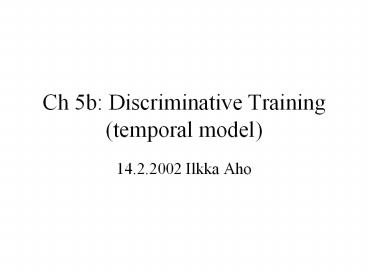Ch%205b:%20Discriminative%20Training%20(temporal%20model) - PowerPoint PPT Presentation
Title:
Ch%205b:%20Discriminative%20Training%20(temporal%20model)
Description:
The MCE framework is used for discriminative training (also MMI is possible) ... How to merge the discriminative power of LVQ with the sequential modeling ... – PowerPoint PPT presentation
Number of Views:51
Avg rating:3.0/5.0
Title: Ch%205b:%20Discriminative%20Training%20(temporal%20model)
1
Ch 5b Discriminative Training (temporal model)
- 14.2.2002 Ilkka Aho
2
Abbreviations
- MCE Minimum Classification Error
- MMI Maximum Mutual Information
- STLVQ Shift-Tolerant Learning Vector
Quantization - TDNN Time-Delay Neural Network
- HMM Hidden Markov Model
- DP Dynamic Programming
- DTW Dynamic Time Warping
- GPD Generalized Probabilistic Descent
- PBMEC Prototype-Based Minimum Error Classifier
3
Basics
- Prototype-based methods use class representatives
(sample or an average of samples) to classify new
patterns - The MCE framework is used for discriminative
training (also MMI is possible) - A central concern is the design or learning of
prototypes that will yield good classification
performance
4
STLVQ for Speech Recognition
- LVQ algorithm in its basic form is a method for
static pattern recognition - STLVQ handles a stream of dynamically varying
patterns (fig. 1.) - STLVQ is much simpler than TDNN model, but
yielded very good results on the same phoneme
recognition tasks
5
Figure 1. STLVQ system architecture.
6
Limitations and Strengths of STLVQ
- STLVQ assumes only a single phoneme as an input
token - Training and testing datasets are obtained from
manually labeled speech databases - How to extend the phoneme recognition to word or
sentence recognition? - LVQ is applied locally
7
Expanding the Scope of LVQ for Speech Recognition
- Representation of longer speech sequences such as
entire utterances - Global optimization
- Application to continuos speech recognition
- A need for some kind of time warping or
normalization - How to merge the discriminative power of LVQ with
the sequential modeling abilities of HMMs? - Two methods LVQ-HMM (fig. 2.) and HMM-LVQ (fig.
3.)
8
Figure 2. LVQ-HMM architecture.
9
Figure 3. HMM-LVQ architecture.
10
MCE Interpretation of LVQ
- A prototype-based implementation of the MCE
framework - The LVQ classification rule is based on the
Euclidean distance between a pattern vector and
each category's reference vectors - The category of the nearest reference vector is
given as the classification decision - Figures 4, 5 and 6 demonstrate the smoothness of
MCE loss
11
Figure 4. Average empirical loss measured over 10
samples from a one- dimensional, two class
classification problem. The ideal zero-one
loss is used in calculating the overall loss.
12
Figure 5. Now a sigmoidal MCE loss, a 0.1, is
used in calculating the overall loss.
13
Figure 6. The same situation as in the figure 5.
except a 1.0 now.
14
Prototype-based Methods Using DP
- DP is used to find the path through a grid of
local matches between prototype and test sample
frames that has the best overall score - When calculating the reference distance between
the input utterance and the reference utterance
it is more practical to use the top path or the
top few paths than every single DP path possible - Nonlinear compressing and stretching prototypes
- DTW is a specific application of DP techniques to
speech processing
15
MCE-Trained Prototypes and DTW
- The idea is to define the MCE loss in terms of a
discriminant function that reflects the structure
of a straightforward DTW-based recognizer - The loss function have to be continous and
differentiable that some gradient-based
optimization technique (for example GPD) can be
used to minimize the overall loss - Also the loss function have to reflect
classification performance - Good results in the Bell Labs E-set task and in
phoneme recognition tasks
16
PBMEC
- PBMEC models prototypes at a finer grain than
MCE-trained DTW - PBMEC prototypes are modeled within phonetic or
subphonetic states - Word models are formed by connecting different
states together - Multi-state PBMEC (fig. 7.)
- The discriminant function for a category is
defined as the final accumulated score of the
best DP path for that category (fig. 8.) - MCE-GPD update rule for PBMEC pulls the nearest
reference vectors for the correct category closer
to the input and pushes the nearest reference
vectors for the incorrect category away - MCE-GPD in the context of speech recognition
using phoneme models (fig. 9.)
17
Figure 7. Multi-state PBMEC architecture.
18
Figure 8. Final DP score.
19
Figure 9. DP segmentations for the words aida
and taira.
20
HMM design based on MCE
- The prototype-like nature of HMMs
- The MCE framework can be applied to HMMs in a
very same way that in the case of the PBMEC model - HMM state likelihood and discriminant function
- MCE misclassification measure and loss
- Calculating of MCE Gradient for HMMs
- There are a very large number of applications of
MCE-trained HMMs - Some of the best context-independent results have
been reported for the Texas Instruments-Massachuse
tts Institute of Technology database
21
Homework Question
Explain the main differencies between following
methods in speech recognition
- STLVQ
- Prototype-based DP (DTW technique)
- HMM design based on MCE































